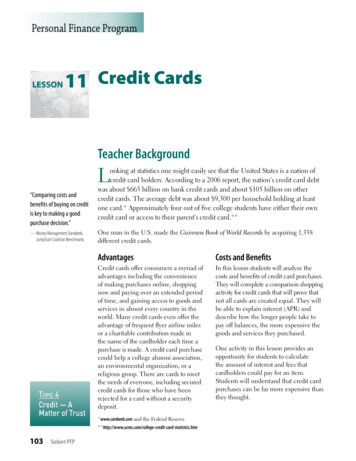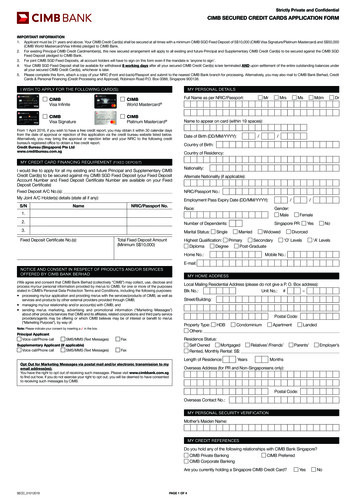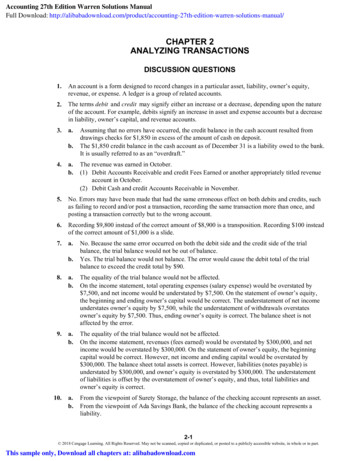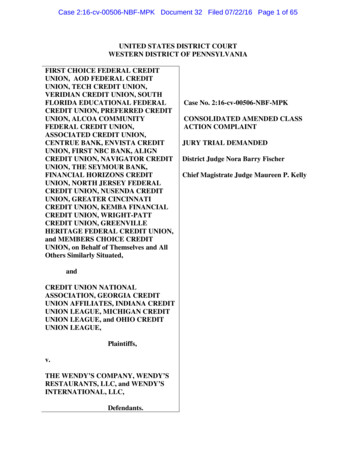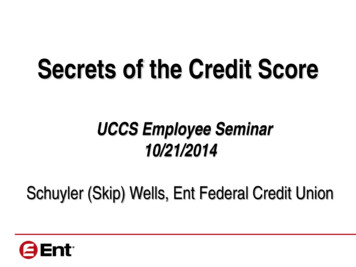
Transcription
NBER WORKING PAPER SERIESTHE SECURED CREDIT PREMIUM AND THE ISSUANCE OF SECURED DEBTEfraim BenmelechNitish KumarRaghuram RajanWorking Paper 26799http://www.nber.org/papers/w26799NATIONAL BUREAU OF ECONOMIC RESEARCH1050 Massachusetts AvenueCambridge, MA 02138February 2020, Revised February 2022The authors thank Dave Brown, Mark Flannery, Chris James, Gregor Matvos and MichaelSchwert and seminar participants at the 2021 American Finance Association meeting, GeorgieInstitute of Technology, HEC Paris, Kellogg School of Management, SMU Cox and Universityof St. Gallen for very helpful comments and discussions. Sanhitha Jugulum and ManvendraTiwari provided outstanding research assistance. Rajan thanks the Fama Miller Center, IGM, andthe Stigler Center at the University of Chicago Booth School for research support. The viewsexpressed herein are those of the authors and do not necessarily reflect the views of the NationalBureau of Economic Research.NBER working papers are circulated for discussion and comment purposes. They have not beenpeer-reviewed or been subject to the review by the NBER Board of Directors that accompaniesofficial NBER publications. 2020 by Efraim Benmelech, Nitish Kumar, and Raghuram Rajan. All rights reserved. Shortsections of text, not to exceed two paragraphs, may be quoted without explicit permissionprovided that full credit, including notice, is given to the source.
The Secured Credit Premium and the Issuance of Secured DebtEfraim Benmelech, Nitish Kumar, and Raghuram RajanNBER Working Paper No. 26799February 2020, Revised February 2022JEL No. E44,E51,G21,G23,G33ABSTRACTCredit spreads for secured debt are lower than for unsecured debt, especially when a firm’s creditquality deteriorates, the economy slows, or average credit spreads widen. Yet investment gradefirms tend to be reluctant to issue secured debt at all times. In contrast, we find that for firms thatare rated below-investment grade, the likelihood of secured debt issuance increases as firm’scredit quality deteriorates, the economy slows, or average credit spreads widen. This differentialpattern of issue behavior is consistent with highly rated firms seeing unencumbered collateral as aform of insurance, to be used only in extremis.Efraim BenmelechKellogg School of ManagementNorthwestern University2001 Sheridan RoadEvanston, IL 60208and NBERe-benmelech@kellogg.northwestern.eduNitish KumarWarrington College of BusinessUniversity of FloridaPO Box 117168Stuzin 312Gainesville, Fl 32611Nitish.Kumar@warrington.ufl.eduRaghuram RajanBooth School of BusinessUniversity of Chicago5807 South Woodlawn AvenueChicago, IL 60637and NBERraghuram.rajan@ChicagoBooth.edu
A vast theoretical and empirical literature in corporate finance and law focuses on the role that collateralplays in corporate lending. 1 In this paper, we attempt to understand the use of secured debt better byanalyzing the pricing of secured debt relative to unsecured debt, both in the cross-section of firms and overtime. Having established the type of firms and the circumstances in which securing debt is especially valued,we explore whether there is greater secured debt issuance under those circumstances. We then offer someexplanations of the patterns we see.It is not easy to estimate the effect of security on credit spreads. The difficulty derives from thecircumstances under which secured debt is issued. Since riskier firms will offer security at riskier times, acomparison across firms of rates offered by secured debt issuances versus rates offered by unsecured debtissuances, or by the same firm over time, will tend to find higher rates for secured debt issuances (see thediscussion in Berger and Udell (1990, 1995), John, Lynch, and Puri (2003)). 2 The way to deal with thisselection problem is to compare yields on secured and unsecured debt issued at the same time by the samefirm (see Berger, Frame, and Ioannidou (2016)). We use three different data sets and variations of thisidentification strategy to get at a better pricing of secured debt, stripped as best as possible of the selectionproblem.Having estimated the secured premium (the difference at a point in time between the yield ofunsecured debt issued by a firm and the yield of its secured debt) both across firms and over time for largedatasets of bonds and loans issued by large U.S. firms, we attempt to understand its determinants, as wellas to use the measured secured premium to explain who issues secured debt, when, and why.We show that, across firms, the secured premium is lower when the firm is large, has low leverage,and a substantial portion of its assets are tangible. The intuition seems straightforward: the lender will notgive up much interest rate spread for the protection offered by collateral in bankruptcy if she is confidentbankruptcy is a low probability event or she will come out whole anyway because there are plentiful assetvalues to back her claim. Relatedly, we find that for investment grade firms, creditors will pay little for theadded protection afforded by security, whereas for below-investment grade firms, they pay a lot. Yields onbonds issued by investment grade firms (those with an S&P rating of BBB or better) are only about 2 basispoints lower when secured, whereas this secured premium jumps to 55 basis points for a firm having abelow-investment grade rating. Similarly, implied yields from bond trades in the secondary market suggestthat investors are willing to give up almost 129 basis points in spread for the added protection of security1Aghion and Bolton (1992), Bolton and Scharfstein (1996), Boot, Thakor, and Udell (1991), Hart and Moore (1994,1998), Hart (1995), Jackson and Kronman (1979), Stulz and Johnson (1985), and Williamson (1985).2Strahan (1999) shows that non-price terms of loans are systematically related to pricing; secured loans carry higherinterest rates than unsecured loans, even after controlling for publicly available measures of risk, suggesting thatthere is an important selection problem.1
for below-investment grade issuers, whereas securing debt lowers the traded spreads by insignificantamounts in the case of investment grade issuers.Moving from the cross-section to time-series variation, we find that as a firm’s credit qualitydeteriorates, the secured premium increases. A transition from a broad rating category of A to a broad ratingcategory of BBB does not change the yield differential between an unsecured and a secured bondeconomically or statistically (holding firm and other bond characteristics fixed). However, a transition fromBBB to BB, from BB to B, and from B to CCC increases the secured premium by an additional 92 basispoints, 21 basis points, and 131 basis points respectively, highlighting the contingent importance ofsecurity. We also find that the secured premium is higher when the Baa-Aaa spread, proxying for conditionsin credit markets, widens. Moreover, most of the time-series variation in the secured premium is driven bythe behavior of spreads of below-investment-grade firms.Turning to debt issuance, we find that secured bond issuance by below-investment grade firmsincreases as the Baa–Aaa spread widens. A one standard deviation increase in Baa–Aaa spread increasesthe probability of issuance of secured bond by below-investment grade firms by an additional 5.2percentage points. Furthermore, correcting for credit conditions, an increase in our monthly measure ofsecured premium is associated with an increase in the likelihood of secured debt issuance by belowinvestment grade firms. So creditors seem to value security more when offered by higher credit risk firmsin situations of systemic financial stress. For investment grade firms, however, we do not find any increasein secured bond issuance when external financial conditions deteriorate, and also little correlation with thesecured premium. More generally, such firms issue very little secured debt: Benmelech et al. (2021) showthat for each of the investment grade rating categories BBB- and above, the median firm issues almost nosecured debt.Why is the secured debt issuance of investment grade firms uncorrelated with the securedpremium, and why, more generally, do such firms not issue secured bonds? In a world with agencyproblems, levered firms should positively want to issue secured debt to reduce agency problems (Stulz andJohnson (1985)) and even to dilute prior debt (Donaldson, Gromb and Piacentino (2019a)). In a world withasymmetric information, secured debt is higher on the Pecking Order than unsecured debt. If so, followingMyers and Majluf (1984), firms should exhaust their secured debt capacity before turning to more juniorclaims. Why don’t they?As Acharya, Almeida, and Campello (2007), Bjerre (1999), Rampini and Viswanathan (2010,2013), and Schwarcz (1997) suggest, the Myers and Majluf argument makes sense in a one shot static modelof investment financing. In a more dynamic model, using up slack today may prevent profitable investmenttomorrow. Following Rampini and Viswanathan (2010, 2013), unused collateral is a form of slack orinsurance that investment grade firms like to preserve if they can issue other forms of debt. Collateral will2
come in use when unexpected adverse shocks hit– for example, when a pandemic shuts down revenues andforces the erstwhile investment grade firm to tap secured debt markets to avert costly bankruptcy. IndeedLi, Whited, and Wu (2016) estimate a structural model based on this idea (of insuring against future quantityconstraints) to suggest that the estimated benefits of a firm retaining flexibility in its ability to issue moredebt (that is, stay a safe distance from the quantity constraint) is on par with the tax advantages associatedwith debt. Following this line of argument, investment grade firms may not issue much secured debtbecause of the high value they perceive to preserving collateral slack and the associated financial flexibility.Interestingly, such behavior may also explain the low secured premium for investment grade firms.One argument is that it is low because their probability of bankruptcy is low. Another, and not mutuallyexclusive one, is that for an investment grade firm with plenty of unencumbered assets, today’s unsecuredbond with protective covenants can demand and get collateral when adverse contingencies arise. So theprospective difference in loss given default between today’s unsecured bond and today’s secured bond issmall. This would imply a low secured premium even were the probability of default to climb somewhathigher. In contrast, for a lower rated firm that has already encumbered much of its collateral, today’sunsecured bond will find it much harder to become secured as adverse contingencies pile up. This mayexplain both their high measured secured premium (since it reflects the difference in spreads betweenunsecured debt with a high probability of remaining unsecured even in distress and currently secured debt)as well as the difficulty of issuing anything but secured debt if the external situation worsens.We offer two pieces of evidence in support of this view. First, and following Rampini andViswanathan (2020), we do find the secured premium is much lower for below-investment-grade firmswhen a firm has significant unencumbered tangible assets, highlighting the role of unencumbered assets insupporting unsecured debt. For example, among below-investment-grade firms, firms with above-medianunencumbered tangibility (that is, net plant, property, and equipment less secured debt scaled by totalassets) have 99 basis points lower secured premium compared to firms with below-median unencumberedtangibility.Second, we examine secured premiums and secured issuances in the early days of the pandemic, anunexpected adverse aggregate shock if ever there was one. Prior to the massive U.S. Federal Reserveintervention on March 23, 2020, all manner of risk spreads blew out, including credit spreads for unsecuredinvestment grade debt, and they came down only gradually as financial conditions eased after the Fedintervention. This suggests the anticipated probability of default went up across the board. Nevertheless,the secured premium for investment grade bonds barely budged from zero, while the secured premium forbelow-investment-grade bonds shot up.These differences are also reflected in the nature of issuance. Investment grade firms issued enormousamounts of unsecured bonds in March, April, and May, even though unsecured bond spreads had increased3
substantially. Only a relatively small portion of their issuances were secured bonds. Below-investmentgrade firms issued very few bonds in March – in contrast to investment grade firms. This suggests themarket had largely shut down for their bonds. They resumed issuance in April, but even so primarily issuedsecured bonds. As financial conditions eased in May and June, the fraction of secured bonds issueddecreased. We find that firms that did issue secured debt over this period had significantly lower outstandingsecured debt on their balance sheet than secured-debt-issuing firms in the past – their collateral slack didcome in handy.One example of a troubled firm that benefited from spare collateral is Carnival Corporation, whichoperates cruise lines. Carnival had an investment grade rating before the pandemic hit, but was bleeding 1billion of cash a month as cruise bookings fell off a cliff. A downgrade was imminent as the pandemic’sconsequences became apparent, and indeed Carnival was downgraded in June 2020 below investmentgrade, and fell a few further notches subsequently. However, in April 2020, it managed a sale of 4 billionof bonds, backed by 28 billion of its ships. The Financial Times wrote, “Carnival had so much freedom topledge its assets because its investment-grade rating meant it was previously able to borrow freely on anunsecured basis.” 3 As we write in January 2022, Carnival has managed to avoid bankruptcy (though notdowngrades), in large part because of its collateral slack.In sum, unencumbered collateral is a lifeline in bad times for stressed firms. This explains whyinvestment grade firms prefer to keep collateral unimpaired by issuing unsecured debt so long as they haveaccess, and also why their secured premium is so low. Untapped collateral is slack!There is a large literature attempting to explain the value of collateral. Most directly related, Berger,Frame, and Ioannidou (2016) use Bolivian banking data, and include firm bank time fixed effects toisolate the effects of securing a loan (so they identify off a borrower obtaining secured and unsecured loansfrom the same bank in a month). They find a positive secured premium of 60 basis points, which is similarin order of magnitude to the secured premium we find. Interestingly, their sample of Bolivian loans doesnot seem to suffer from the selection problem that is central to the U.S. loan and bond datasets we studyand which our empirical methodology addresses—the unconditional correlation between loan spread andcollateral in Berger, Frame, and Ioannidou’s sample is negative and the baseline regression result that doesnot attempt to address the selection problem leads to a similar estimate of the secured premium as the fullysaturated model that includes firm bank time fixed effects. In contrast, for the broad sample of loansand bonds in the U.S. that we study, we show that controlling for selection is important.Cerquiera, Ongenga, and Roszbach (2016) identify the value of securing debt from a naturalexperiment in Sweden in 2004, where the authorities introduced legal changes that reduced the value of3“Why Cruise Ship Backed Bonds Drew 17 billion of demand”, Financial Times, April 7, -bee3-b32eb9c598f94
floating liens – so identification is from changes over time around the exogenous legal change. Faced withless effective collateral, the lenders increased interest rates, and monitored less frequently (consistent witha loss of lender enforcement power when the lender has less collateral). In response, borrowers seemed tobecome more lax, missing payments to tax authorities and other lenders more frequently.Schwert (2020) and Luck and Santos (2021) use a similar identification method to Berger et al.(2016), as we do, but have a different focus. Schwert’s objective is to isolate the premium in bank lending,relative to the bond-implied credit spread. He finds it is higher than would be suggested by a competitivebank loan market. Like us, Schwert also estimates the secured premium for bonds, though the focus of hispaper is not on the determinants of the secured premium and its link with secured debt issuance. Luck andSantos (2021) estimate the secured premium for bank loans in the United States, focusing on the premiumassociated with different types of collateral – marketable securities have a higher secured premium thanaccounts receivable or inventory, which in turn trumps real estate. They too find little or no premium forlarge, publicly listed firms. Our primary contribution relative to all these papers is to use the measuredsecured premium both across firms and over time to explain who issues secured debt, when, and why.A large literature explores the use of covenants in debt contracts and how they vary with the stateof the firm and the cycle (see, e.g., Begley (1994), Bradley and Roberts (2015), and Malitz (1986)). Inparticular, Bradley and Roberts (2015) use DealScan data to examine the timing and pricing of covenants,including security. Although their method of correcting for selection is different, they find as we do thatcovenants are priced by lenders and are more likely to be used in business cycle troughs. We add to thisliterature as well by documenting the behavior of secured debt and show that security is also priced in publicdebt issuances. We also offer an explanation for the reluctance of highly rated firms to issue secured debt.Finally, a growing literature (see Lian and Ma (2021), Kermani and Ma (2020), and Ivashina,Laeven, and Moral-Benito (2020)) distinguishes between debt secured by specific assets (asset-based) anddebt contracts that are based on cash flows (cash flow-based) – in their view, the key difference is how thedebt is resolved in bankruptcy (as also its ability to enforce repayment in the normal course). Some formsof cash flow-based debt are secured by blanket liens on assets. Interestingly, we find the secured premiumfor both forms of secured debt (that is, the spread on asset-based secured vs unsecured, and the spread oncash flow-based secured vs unsecured) is positive and significant, with asset-based debt having a highersecured premium than cash flow-based secured debt when both are issued in the same loan package. Thesecurity of assets (either specific assets or a blanket lien) is thus important in both forms of debt, at least insupporting repayment.The rest of the paper is organized as follows. Section I outlines our identification strategy anddescribes the data sets used. Section II reports estimates of the secured premium. Section III investigateshow the secured premium varies with firms’ characteristics and risk. Section IV examines the behavior of5
the secured premium and issuance over the business cycle, and analyzes the correlations of issuances withthe secured premium. In Section V we discuss theoretical explanations for why secured debt is used sosparingly by investment grade firms. We provide supportive evidence from the unpledged tangibility offirms and the pattern of issuances at the onset of the unexpected coronavirus pandemic. In Section VI, weapply our methodology to the newly emerging classification of debt (cash flow-based versus asset-based)and we conclude in Section VII.I.Data and Empirical Strategy to Measure Secured PremiumWe start by describing the identification strategy for measuring the secured premium, and show that withthe appropriate identification strategy, it is indeed positive, both for bank loans and for bonds.A. Identification StrategyThe difficulty in identifying the effects of security on debt yields stems from the circumstancesunder which it is offered – that riskier firms will offer security at riskier times (see, for example, Bergerand Udell (1990)). This introduces a selection problem that makes it difficult to measure the effect ofsecurity on credit spreads. Indeed, in a comparison of rates offered by secured debt issuances against ratesoffered by unsecured debt issuances across firms, a number of studies have found a positive relationbetween credit spreads and whether debt is secured, despite attempting to control for issuer quality (see theextensive discussion in Berger, et al. (2016)).To address the selection problem, our identification strategy attempts to compare spreads onsecured and unsecured credit of the same firm and at the same point in time. We estimate the followingregression 𝑠𝑠𝑠𝑖𝑖,𝑗𝑗,𝑡𝑡 𝛽𝛽 ��𝑠𝑖𝑖,𝑗𝑗,𝑡𝑡 𝜃𝜃𝑋𝑋𝑖𝑖,𝑗𝑗,𝑡𝑡 δ𝑗𝑗,𝑡𝑡 ε𝑖𝑖,𝑗𝑗,𝑡𝑡 ,(1)where ��𝑖,𝑗𝑗,𝑡𝑡 is the spread for debt i of firm j at time t. The variable ��𝑠𝑖𝑖,𝑗𝑗,𝑡𝑡 is a dummy thatequals one if debt i is secured, and zero otherwise. Our primary interest is in β , which we term thesecured premium, or the extent to which securing the debt reduces the yield spread. The variable 𝑋𝑋𝑖𝑖,𝑗𝑗,𝑡𝑡controls for debt characteristics, while δ𝑗𝑗,𝑡𝑡 represents firm time fixed effects. We use three main data setsto estimate regression (1): DealScan, Mergent, and TRACE. To ensure that our results are not driven byother characteristics that might vary systematically between secured and unsecured debt, we control forsuch debt characteristics as seniority, maturity, loan amount, presence of covenants, and callability.Clearly, we are not the first to address the selection problem in measuring the secured premium.Cerquiero et al. (2016) examine how spreads charged by a bank to existing borrowers change when loansare repriced following a change in laws governing collateral’s use – in a sense they use the time variation6
in spreads following an exogenous change in the laws to estimate the value of securing a loan. Berger et al.(2016) is an early paper using the technique we use – of examining the spread between secured andunsecured debt of the same borrower at the same point in time. As indicated in the introduction, though,our focus is on using the measured secured premium both across firms and over time to explain who issuessecured debt, when, and why.B. DealScan Loan DataWe obtain information on corporate loans from the Thompson Reuters DealScan database, whichcontains detailed information about bank loans made to U.S. and foreign corporations, with coveragestarting in the mid-1980s. Because DealScan coverage is limited and information on contract characteristicsis sporadic before 1994, we restrict our analysis to the 1994-2018 time period. 4 The basic unit of observationin DealScan is a loan facility. Multiple loan facilities are often part of a single deal (or package). 5 The datacontain information on the different attributes of a loan facility, such as the amount, promised yield,maturity, security, and seniority. What is important here is that the same loan deal may contain both asecured facility and an unsecured facility.We apply three filters to the DealScan data. First, we restrict our analysis to dollar-denominatedloans granted to nonfinancial U.S. firms. 6 Second, since we focus on measuring the cost of secured debt,we require the all-in-drawn spread and secured status for loans to be available. Finally, given that ouridentification strategy for the DealScan data relies on within-package variation, we exclude loan facilitiesoriginated more than a month after the first facility in a package is originated. 7 Our final data set contains50,614 facilities from 32,420 loan packages. Panel A of Table I provides summary statistics on keyvariables from DealScan used in our analysis. Spread is measured as the promised yield minus the maturitymatched LIBOR at issuance. The mean (median) spread in our sample is 285 (255) basis points. About 85%of facilities are secured, and the mean (median) maturity of a loan facility is 3.9 (4.1) years. A negligiblenumber of facilities (55 of 50,614) are subordinated or junior loans. Covenant is a dummy that equals oneif the loan contract contains one or more financial covenants, and zero otherwise. One or more financialcovenants were contained in 53% of loan facilities.4Chava and Roberts (2008) also restrict their analysis to the time period beginning 1994.According to Sufi (2007): “ the actual syndicated loan contract is drafted at the deal level, and covenants and alllenders are listed together on this contract, even if a lender loans only on one tranche. While the maturity and pricingof the loan tranches can vary within a syndicated loan deal, there is one contract, and all lenders are chosen on thetranches collectively, not independently”.6We drop financial firms (SIC codes 6000–6999) and government agencies (SIC codes 9000–9999).7This ensures that the issuing firm’s fundamentals do not change between the issuance of multiple facilities. Theresults are not sensitive to this restriction as only a small percentage of facilities are originated with significantdelay.57
C. Mergent Bond DataWe obtain information on bond issuances from the Mergent Fixed Income Securities Database – acomprehensive database of publicly offered U.S. bonds. The FISD contains detailed information on morethan 140,000 bonds. Although the Mergent data set also includes bonds issued before the 1980s,comprehensive coverage for our purposes starts around 1980. Mergent uses seven broad categories toclassify the security level of bonds: (i) junior, (ii) junior subordinate, (iii) senior, (iv) senior subordinate,(v) subordinate, (vi) senior secured, and (vii) none. We classify bonds as secured if Mergent assigns themto the senior secured category. We supplement Mergent’s classification of secured bonds with a textualanalysis of bond names, searching for the following strings: “EQUIP,” “MTG,” “BACKED,” “COLL,” and“1st.”.We omit bonds issued by financial firms and government agencies. We drop convertible bonds andbonds with floating rates. We further require the offer-yield at issuance and the bond maturity to beavailable. Spread is calculated as the yield spread at issuance over the maturity-matched treasury bond (seeGurkaynak, Sack and Wright (2007)). We drop bonds with maturity greater than 30 years because we cannotmatch them with similar-maturity treasury securities. This results in a sample of 30,041 individual bondofferings from 1980 to 2018. Panel B of Table I provides summary statistics on key variables from Mergentused in our analysis. The mean (median) spread in our sample is 208 (124) basis points. About 15% ofbonds are secured, and the mean (median) maturity of a bond is 11 (10) years. A bond is classified as seniorif Mergent assigns it to the senior or senior secured categories. Of the bonds, 91% are senior (including allthe secured bonds), 67% are callable, and 40% have one or more covenants protecting bondholder interest.We have issuer rating information for 22,541 bond issues. Below-IG is a dummy that takes thevalue of one if the issuing firm had a below-investment-grade rating (BB or lower) from S&P at the timeof bond issuance. At the time of issuance, 24% had a below-investment-grade issuer rating.D. TRACE DataWe supplement the issuance data with information on secondary bond trades from the TRACEdatabase. 8 TRACE reports dates, implied yields, and prices at which bonds trade. We follow Bessembinder,Kahle, Maxwell, and Xu (2009) and Dick-Nielsen (2009) in cleaning the data. In particular, we excludetrades that are canceled or corrected, and we discard all but one transaction when multiple similar tradesoccur very closely in time. For a given bond, we calculate trade-volume weighted implied yield at the dailyfrequency using all transactions for the bond taking place each day. We augment the data with information8Trade Reporting and Compliance Engine was introduced by FINRA in July 2002. All broker-dealers who are FINRAmember firms have an obligation to report transactions in corporate bonds to TRACE under an SEC-approved set ofrules.8
on bond characteristics (security, seniority, and so on) from Mergent. Our cleaned and merged TRACE dataset contains 3,675,393 observations at the bond-date level.Panel C of Table I provides summary statistics on key variables from TRACE used in our analysis.Spread is calculated as the difference between implied yield from secondary trade prices and the yield onthe maturity-matched treasury. The mean (median) spread in our sample is 212 (142) basis points. Around8% of observations are for secured bonds, and the mean (median) remaining maturity of a bond at the timeof trade is 8.9 (6) years. A bond is classified as senior if Mergent assigns it to either the senior or seniorsecured categories. Senior bonds comprise 99% of observations, while 93% of observations are for bondsthat are callable and 90% are of bonds that have one or more covenants protecting bondholder interest.Below-IG is a dummy that takes the value of one if the issuing firm had a below-investment-grade rating(BB or lower) from S&P at the time of the secondary trade. We have issuer rating information for2,777,603 observations. Of these, 21% are for bonds that had a below-investment-grade issuer rating. Weaugment trade data with information on firm characteristics from Compustat. Size is measured as thelogarithm of the total value of the firm’s assets in millions of dollars, Age is number of years since thefirm’s first entry in Compustat, ROA is calculated as operating income scaled by total assets, Leverage istotal debt scaled by total assets, and Tangibility i
increases as the Baa-Aaa spread widens. A one standard deviation increase in Baa-Aaa spread increases the probability of issuance of secured bond by investment grade firms by an additional 5.2 below-percentage points. Furthermore, correcting for credit conditions, an increase in our monthly measure of


